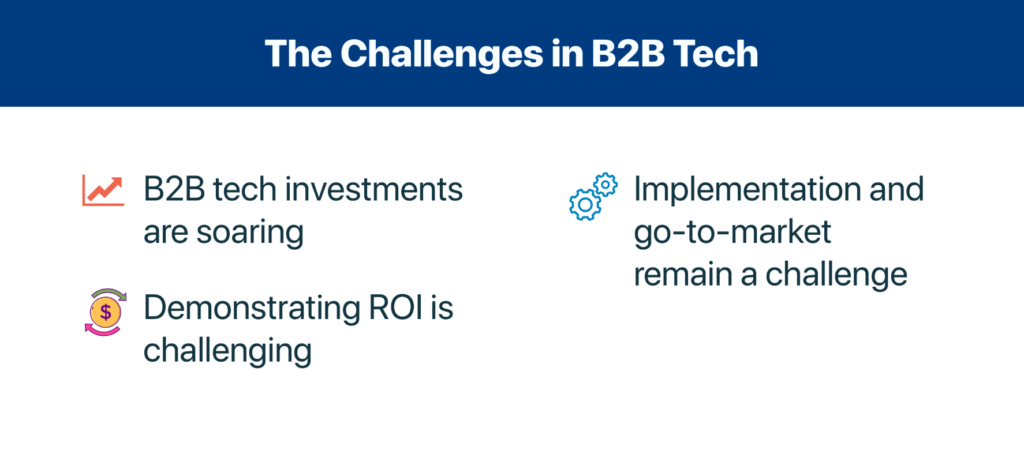According to McKinsey, B2B digital leaders who invest in the appropriate technologies and practices drive five times more revenue growth than their peers. By selecting one or two high-value customer segments and mapping their decision journeys in full to understand how these customers buy, what channels they use, what influences their decision making, and what turns them off, these companies are then able to break the digital-transformation process down into bite-size pieces that they can test and enable to find success.
However, making such an investment isn’t easy and it’s hard to know exactly when and where to take that approach. Oftentimes, companies who go into investments and digital transformation without a plan fail, with only 28% of legacy companies having succeeded at implementing a digital-first strategy.
With a number of companies facing agility or failure without adoption, how do we go about implementing the right technologies, and what are the challenges in B2B tech? Here are some of the unique obstacles for companies trying to conquer the B2B world.

1. B2B tech investments are soaring
Analyst firm Sirius Decisions reports, “With the pressure to gain or maintain competitive advantage coupled with the continuous marketing around new technologies, organizations are investing in technology at unprecedented levels.” Gartner also backs this claim, reporting that the highest expenditure for marketing executives is technology solutions at 29% of their total budgets – a larger portion than they designate to anything else, including hiring new teams.
Technology is changing the way that we work, in a lot of ways for the better. It allows our teams to become data-driven and to use that data to create the personalized experiences customers have come to expect.
However, without a plan for said data, it can lead to sprawl. For companies who don’t have an insightful, human-driven strategy guiding their outputs, it can lead to a proliferation of unnecessary technologies, applications, and data — which, in turn, can cause multiple customer handoffs between functions, long turnaround times for projects, and missed delivery dates — problems they were likely trying to avoid in the first place.
From a business systems standpoint, you have to make sure the technology fits in with your infrastructure. It has to integrate well with the other apps in your ecosystem. On the other hand, lines of business teams (Marketing, Sales, HR) often drive technology purchases without oversight from or collaboration with IT or Business Systems. You want IT and Business Systems to be seen as an enabler of productivity, not someone standing in the way. To strike a balance, it’s best to invest in an integration and automation platform that is agile enough to enable the lines of business to choose whatever technology they prefer.
In short: you shouldn’t be investing in a technology that stands completely alone if you don’t have a plan for how you’re going to integrate and automate it into your processes.
Related: 5 ways to automate B2B sales processes
2. Implementation and go-to-market remain a challenge
Despite growing investments in B2B technology, many B2B firms still struggle with utilizing their solutions. According to Sirius Decisions, the top two concerns of B2B firms regarding new technologies are incorporating them into a new go-to-market strategy (68%), and properly implementing them for everyday use (59%).
When it comes to marketing and sales use, the technology needs to be able to integrate into the department’s existing workflows. For implementation into daily use, you might have to get creative and allow marketing and sales to access data from an app like Salesforce or Marketo inside of an app they spend more time in naturally, like Slack.
Here’s an example: Sales reps must log all their sales activities in Salesforce, like when they give a demo, as well as when something changes like expected deal size or close date. However, reps are often too busy selling and don’t keep their deals updated. That means all the intermediary information, which is critical to projecting how the company will perform in the coming months, is poor.
One solution might be to create a Deal Desk in Slack. This allows reps to update prospects from inside of Slack. It also makes key data just a button click away — they can view their individual pipeline, key details of an account, update an account, provide deal assistance, track meetings and demos, and obtain secure approvals — all in Slack.
The other consequence of failed implementation? Rampant IT support. As the lines of business struggle to implement a foreign technology into their processes, more support tickets and hand-holding will be required from IT and Business Systems. With the onslaught of additional help, the business systems team gets backlogged with requests and the lines of business teams that are waiting on help face a bottleneck.
3. Demonstrating ROI is challenging
According to the Sirius Decisions report, “Despite the continued investment in technology, ROI proves to be elusive.” As may be expected, if a company has trouble implementing technology, then they’ll also face problems proving its value.
We know technology makes things easier and enables better processes, but it can be very difficult to quantify just how much. Indicators like ability to meet your SLA response time in customer service, lead attribution so you know which marketing campaigns are working, and seeing the full sales pipeline to better calculate volume and enable velocity are great ways to prove ROI.
In order to calculate and monitor any of these ROI indicators, you need to move data into a central place or track the progress of information from one app to another. Paysafe, a leading provider of payment processing solutions for small to midsize businesses that serves more than 137,000 customers, does this with an intelligent automation platform. They are able to offer merchant cash advances in 1 day while other banks can take months, thanks to their automations between Zendesk, Salesforce, and DocuSign.
“Once Workato notes that the contract has been signed in Zendesk and Salesforce, the workflow continues, notifying the sales rep and the underwriters that the contract has been signed. As the process continues, Workato is actually updating Zendesk and Salesforce to keep the statuses synced,” explains Deidre Jones, the Manager of Service Applications and Technology. “We have several Workato integrations between Zendesk, Salesforce, and DocuSign, and using Workato has greatly improved that process.”
Quick Base, a software company trusted by half of the Fortune 100, was able to see a huge ROI from their applications on the Sales side. Quick Base automated the process for properly crediting everyone involved in the sales cycle and calculating commissions. “Now reps can see where they stand in terms of their quota every morning,” comments Timothy Famolare, Manager of FP&A. “With Workato, reps, managers, and senior leadership members have real-time visibility inside of our CRM.”
Overcoming these challenges with an Intelligent Automation Platform
Both hypergrowth companies and established enterprises are implementing and going to market faster with intelligent automation. Hyperconverged infrastructure leader Nutanix increased capacity by 30% by adopting automations based in Machine Learning and other tools that auto-provision virtual machines (VMs) to help run business and empower a bot-based ticket protocol that assigns tickets 2x’s faster, driving efficiency.
With automations between Splunk, Okta, ServiceNow and Slack, Nutanix also built a security self-service tool, allowing employees to request their personal security health checkup upon command directly from Slack and submit related IT tickets, if necessary. This, in turn, increased the entire organization’s security by encouraging people to see what needs to be fixed and take action on it, all within Slack, and improved customer satisfaction from an IT perspective.
Israeli-American enterprise data storage company Infinidat quickly implemented 200+ automations to rapidly scale HR, eCommerce and IT ops within weeks – a job that would’ve taken its engineering team years to handle internally.
